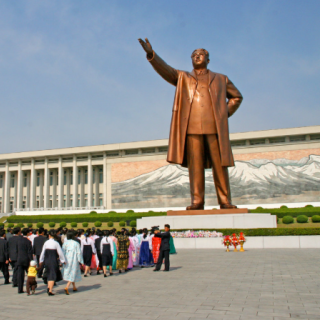Advertisement
Should we take up a public collection to send Columbus’ “mayor,” at-large unrepresentative city councilors, and non-expert department heads to visit Toronto? Every Columbus resident and voter suspicious of the “Columbus Way” and “Opportunity for ‘a few’ city” should spend time just north of the US-Canadian border in Toronto, Ontario, now the 4th largest city in North America. Canada’s largest city and Ontario’s capital is at once a great city and a challenged city, with countless lessons to teach the much smaller, alienating, undemocratic city with no identity and no history, Columbus, Ohio. We could require our “leaders” to pass a course on cities and urbanism 101 before taking office and for continuing in office.
Two weeks ago, I visited the city where I lived from 1970-1975 while I completed graduate studies at the University of Toronto. To add context, my partner and I were Landed Immigrants, not Resident Aliens, and received free health care instituted not by socialists but by Ontario’s Progressive Conservative party. Tuition at one of the hemisphere’s premier public universities was (and is) far less than comparable US institutions.
Toronto in the 1970s was a thriving, growing, diversifying metropolis with a model inner- and outer-city governmental structure. It was also affordable for two young students living on a small income of fellowships, grants, and part-time work. We had no need for a car.
Growing up in Pittsburgh then transitioning from Big Steel to an incomplete and unequal white collar “new city,” I moved from Chicago and Evanston to Toronto after graduating from Northwestern University in 1970 and driving a taxi cab in the intervening summer months.
Although I have returned to my former city a number of times for lectures, seminars, and conferences, this time I walked the streets and pounded the pavements extensively. I examined the relationships between the old and the towering new, with far too many 40, 50, and increasingly 60-story towers, all over the spreading city. Toronto’s housing prices rival Manhattan’s.
My comparison is based on personal familiarity over more than a half-century and my knowledge as an urban historian and life-long city resident. I walked the streets with one graduate school friend who is the major historical geographer of Toronto and another half-century resident professor and activist.
Unlike Columbus, Ontario’s provincial capital wears its historical and identity proudly: culturally, socially, visibly, and physically. It is internationally diverse, in all senses of that complex concept. Diversity colors the city from its well-populated sidewalks, streetcars, trolleys, buses, and subways, to its internationally-known institutions. It is among the most diverse in North America. We stayed near our graduate student apartments close to the university and vibrant Bloor St West, the historic Annex residential area, Yorkville, and retail-entertainment districts. Toronto is at once transformed and much the same.
The all-day public presence of friendly people of all races, ethnicities, genders, and ages is palpable. Children and dogs, large and small, were everywhere. We never saw dog poop, broken sidewalks, or trash on streets or sidewalks. Our Toronto friends commented that there was a trash problem. It was not visible.
We had frequent, impromptu conversations around the university and elsewhere, on sidewalks and in restaurants and shops especially with young people from around the world eager to learn about their city 50 years ago. People smile and say hello to strangers.
Public transit has always been excellent. It has grown and modernized as the city spreads. The coexistence of streetcars and subways, alongside cars, is distinctive. Well-used, safe bicycle lanes mark the entire city. Electric scooters are almost invisible even in student areas. Fraternity lawns on Saturday and Sunday morning held surprisingly little litter and no beer cans or whiskey bottles.
Much of Toronto’s exponential growth, especially in high-rises, is very recent, although it built on a rising base. It is controversial with respect to location, zoning, design, height, and especially prices. Recent more conservative city and Ontario governments support development and developers, and density in the face of political opposition.
The city’s population is less than comfortable with its course of growth and political leadership since the early 1990s and especially in the last 7 or 8 years. The mayor’s power has increased and the number of elected city councilors has been reduced dramatically. At the same time, most Canadians have not lost their faith in political and social institutions. There are no parties at the municipal level, only leanings “left” or “right.” Immigration is seen as positive.
At the same time, compared to Columbus, Ohio, City Council is much more representative and politics more open and engaged. City councilors are full-time representatives of defined constituencies. With a now smaller council, service to constituents is a major concern of representatives and constituents alike. Yet, it remains easy to reach councilors, my sources report.
Major central city developers often exhibit significant interest in the public city and its residents including community centers, playgrounds, open spaces, room for schools, and the like. Three major universities, art institutions, and technology training schools actively engage the city. Cultural institutions are legitimately world-class.
The contrasts with Columbus, Ohio are stark in all dimensions. Toronto is a great city, a world city, with four newspapers (The Globe and Mail is Canada’s newspaper of record); major professional broadcast media including the Canadian Broadcasting Corporation; professional hockey, basketball, baseball, and other sports teams; and an international presence in museums, public arts, and the world’s second largest international film festival. The hockey and basketball arena was built in 1999 without any public funds.
Despite changes and criticisms, Toronto’s, and Ontario’s, city and public services function generally well. The city is clean and generally safe; crime especially major and violent crime is relatively low; police are not physically violent or quick to shoot; food and health care deserts are little present. Free health care is guaranteed for all.
Poverty, insufficient affordable housing, and demographic differentials certainly exist but are demonstrably less—and less visible--than in Columbus, Ohio. There is no segregation. Despite several decades of conservative dominance, people still count.
Despite substantial expansion of expensive high-rise housing and gentrification of historic neighborhoods, older housing stock and private ownership remain. Both preservation and expansion of truly (not false or token) affordable housing is a central concern across political and developmental lines.
To a returning resident who is also a historian, the preservation of the historic city in commercial, residential, and recreational areas since the 1950s and 1960s is both surprising and significant. (There was significant loss to development before that time.) Although challenged by developers, it marks the city impressively. It sometimes takes the form of hybrid combinations of the new and old, including contentious trades-offs between more height and public, open spaces.
Yes, housing prices are high, although extensive and still expanding public transit and other daily costs are not as high when compared closely. The extent of well-used public spaces, preservation, and renovation throughout the city, for all ages dramatically counters the many poorly-designed and overly tall skyscrapers.
One relevant metaphor is that the foundational and the living city of Toronto and the upwardly and outwardly spreading new accommodate each other on the ground like the contesting pieces on a chessboard. Old and new public spaces are more complementary than oppositional. So are cars, bicycles, buses, streetcars, and subways. Toronto is also well-connected by commuter rail. In Columbus, that remains a pipe dream.
The pieces include the young and old. And visibly the intermixing South and East Asians, Middle Easterners, Blacks from around the world, Latinx, large numbers of Indigenous Peoples, French and English Canadians, American and European Caucasians, and substantial intermixed population.
Columbus, Ohio, searching to be a city, meet the city of Toronto. 430 miles but worlds apart.
------------------------------------------------------------
Harvey J. Graff is Professor Emeritus of English and History at The Ohio State University and inaugural Ohio Eminent Scholar in Literacy Studies. Author of many books, he writes about a variety of contemporary and historical topics for Times Higher Education, Inside Higher Education, Academe Blog, Washington Monthly, Publishers Weekly, Against the Current; Columbus Free Press, and newspapers. Searching for Literacy: The Social and Intellectual Origins of Literacy Studies was published by Palgrave Macmillan in August. My Life with Literacy: The Continuing Education of a Historian. The Intersections of the Personal, the Political, the Academic, and Place is forthcoming. He thanks Michael Doucet, Tom Cohen, and Louise Neville for guiding him.



